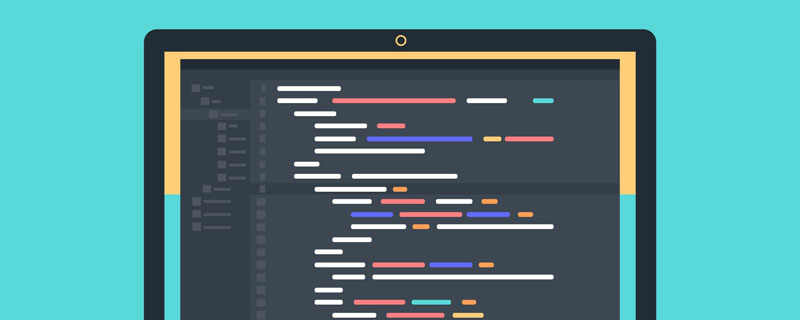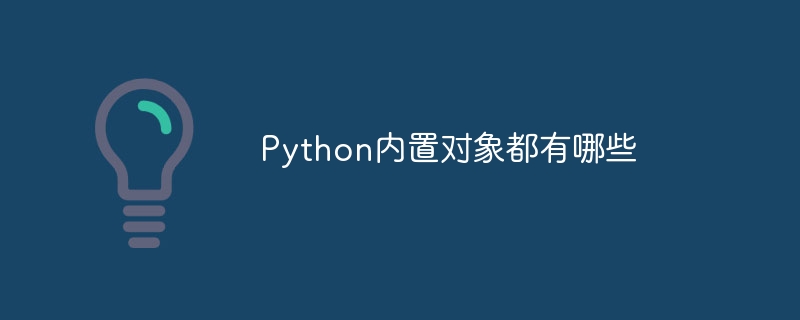The built-in objects in ecmascript include: global object, Object object, Function object, Array object, String object, Boolean object, Number object, Math object, Date object, RegExp object, JSON object, and Error object.

The operating environment of this tutorial: Windows 7 system, ECMAScript version 6, Dell G3 computer.
ECMAScript defines a set of built-in objects that outline the definition of ECMAScript entities.
These built-in objects include:
Global object, Object object, Function object, Array object, String object, Boolean object, Number object, Math object, Date object, RegExp object , JSON object, and Error object: Error , EvalError , RangeError , ReferenceError , SyntaxError , TypeError , URIError .
Global Object
The only global object is created before control enters any execution environment.
Unless otherwise specified, the standard built-in properties of global objects have the properties {[[Writable]]: true, [[Enumerable]]: false, [[Configurable]]: true}.
The global object does not have [[Construct]] internal properties; the global object cannot be called as a constructor using the new operator.
The global object does not have [[Call]] internal properties, and the global object cannot be called as a function.
The [[Prototype]] and [[Class]] internal property values of global objects are implementation-dependent.
In addition to the properties defined by this specification, global objects can also have additional host-defined properties. A global object can contain a property whose value is the global object itself; for example, in the HTML Document Object Model, the global object's window property is the global object itself.
Object Object
Call the Object constructor as a function
Treat Object as a function to call instead of a constructor, it performs a type conversion.
Object ( [ value ] )
When calling the Object function with a parameter value or no parameters, use the following steps:
If value is null, undefined or unspecified, create and return a A new Object object, which is the same as the result of calling the standard built-in Object constructor (15.2.2.1) with the same parameters.
Return ToObject(value).
Object Constructor
When Object is part of a new expression call, it is a constructor that creates an object.
new Object ( [ value ] )
When calling the Object constructor with a parameter value or no parameters, use the following steps:
If value is provided, then if Type(value) is Object, then if value is a native ECMAScript object, no new object is created, and value is simply returned. If value is a host object, actions are taken and implementation-dependent The method of the result can depend on the host object. If Type(value) is String, return ToObject(value). If Type(value) is Boolean, return ToObject(value). If Type(value) is Number, return ToObject( value).
Assertion: The parameter value is not provided or its type is Null or Undefined.
Let obj be a newly created native ECMAScript Object.
Set the [[Prototype]] internal property of obj to the standard built-in Object prototype object (15.2.4).
Set the [[Class]] internal property of obj to "Object".
Set the [[Extensible]] internal property of obj to true.
Set all internal methods specified in 8.12 of obj
Return obj.
Function object
Call Function constructor as a function
When a Function is called as a function, rather than as a constructor, it creates and initializes a New function object. So the function call Function(…) creates the same object as the new Function(…) expression with the same parameters.
Function (p1, p2, … , pn, body)
When calling the Function function with p1, p2, …, pn, body as parameters (n here can be 0, that is to say, there is no "p" parameter, and the body does not need to be provided at this time), use The following steps:
Create and return a new function object, as if it were created with the same parameters to the standard built-in constructor Function (15.3.2.1). Use a new expression.
Function constructor
When a Function is called as part of a new expression, it is a constructor: it initializes the newly created object.
new Function (p1, p2, … , pn, body)
The last parameter is specified as the body (executable code) of the function; any previous parameters are specified as formal parameters.
When calling the Function constructor with p1, p2, …, pn, body as parameters (n here can be 0, which means there is no "p" parameter, and body does not need to be provided at this time), use The following steps:
令 argCount 为传给这个函数调用的参数总数 .
令 P 为空字符串 .
如果 argCount = 0, 令 body 为空字符串 .
否则如果 argCount = 1, 令 body 为那个参数 .
否则 , argCount > 1令 firstArg 为第一个参数 .令 P 为 ToString(firstArg).令 k 为 2.只要 k
令 body 为 ToString(body).
如果 P 不可解析为一个 FormalParameterListopt,则抛出一个 SyntaxError 异常 .
如果 body 不可解析为 FunctionBody,则抛出一个 SyntaxError 异常 .
如果 body 是严格模式代码 ( 见 10.1.1),则令 strict 为 true, 否则令 strict 为 false.
如果 strict 是 true, 适用 13.1 指定抛出的任何异常 .
返回一个新创建的函数对象,它是依照 13.2 指定 -- 专递 P 作为 FormalParameterList,body 作为 FunctionBody,全局环境作为 Scope 参数,strict 作为严格模式标志 -- 创建的。
每个函数都会自动创建一个 prototype 属性,用来支持函数被当做构造器使用的可能性。
为每个形参指定一个参数是允许的,但没必要。例如以下三个表达式产生相同的结果:
new Function("a", "b", "c", "return a+b+c") new Function("a, b, c", "return a+b+c") new Function("a,b", "c", "return a+b+c")Array 对象
数组是值的有序集合,数组中的每个值称为一个元素,每个元素在数组中都有一个数字位置,称为索引,索引从 0 开始,依次递增。在 JavaScript 中,您可以使用 Array 对象定义数组,此外,Array 对象中还提供了各种有关数组的属性和方法。
创建 Array 对象的语法格式如下:
var arr = new Array(values); var arr = Array(values);
其中,values 为数组中各个元素组成的列表,多个元素之间使用逗号分隔。
String 对象
String 对象用于处理字符串,其中提供了大量操作字符串的方法,以及一些属性。
创建 String 对象的语法格式如下:
var val = new String(value); var val = String(value);
其中参数 value 为要创建的字符串或字符串对象。
JavaScript 中,字符串和字符串对象之间能够自由转换,因此不论是创建字符串对象还是直接声明字符串类型的变量,都可以直接使用字符串对象中提供的方法和属性。
Boolean对象
JavaScript 布尔值可以有以下两个值之一:true 或 false。
作为函数调用布尔构造器
当把 Boolean 作为函数来调用,而不是作为构造器,它执行一个类型转换。
Boolean (value)
返回由 ToBoolean(value) 计算出的布尔值(非布尔对象)。
布尔构造器
当 Boolean 作为 new 表达式的一部分来调用,那么它是一个构造器:它初始化新创建的对象。
new Boolean (value)
新构造对象的 [[Prototype]] 内部属性设定为原始布尔原型对象,它是 Boolean.prototype (15.6.3.1) 的初始值。
新构造对象的 [[Class]] 内部属性设定为 "Boolean"。
新构造对象的 [[PrimitiveValue]] 内部属性设定为 ToBoolean(value)。
新构造对象的 [[Extensible]] 内部属性设定为 true。
Number 对象
在 JavaScript 中您可以使用十进制、十六进制或八进制表示法来表示整数或浮点数。与其它编程语言不同,JavaScript 中的数字并不区分整数和浮点数,统一使用 IEEE754 标准(二进制浮点数算术标准)的 64 位浮点格式表示数字,能表示的最大值(Number.MAX_VALUE)为 ±1.7976931348623157e+308,最小值(Number.MIN_VALUE)为 ±5e-324。示例代码如下:
var x = 123; // 整数 var y = 3.14; // 浮点数 var z = 0xff; // 十六进制数:255
对于比较大的数字可以使用指数表示法来表示,例如 6.02e+23 等于 6.02 x 10²³,示例代码如下:
var x = 1.57e4; // 等于 15700 var y = 4.25e+6; // 等于 4250000 var z = 4.25e-6; // 等于 0.00000425
提示:JavaScript 中能够表示的最大的整数是 2⁵³ - 1,即 9007199254740991,能够表示的最小整数是 -(2⁵³ - 1),即 -9007199254740991。
除了可以使用十进制表示数字外,您也可以使用八进制或十六进制表示法来表示数字,其中八进制表示法使用 0 作为前缀,十六进制表示法使用 0x 作为前缀,示例代码如下:
var a = 0377; // 等于 255 var b = 0123; // 等于 83 var c = 0xff; // 等于 255 var d = 0xb4; // 等于 180
注意:整数可以用十进制、十六进制和八进制表示法表示,浮点数可以用十进制或指数表示法表示。
Math 对象
Math 是 JavaScript 中的一个内置对象,其中提供了一些数学中常用的常量值和函数,用来实现一些数学中常见计算,例如计算平均数、求绝对值、四舍五入等。
与前面介绍的几个对象(例如 Number 对象、String 对象、Array 对象等)不同,调用 Math 对象中的属性和方法无需预先使用 new 运算符来创建它,直接将 Math 作为对象调用即可,例如:
var pi_val = Math.PI; // 数学中 π 的值:3.141592653589793 var abs_val = Math.sin(-5.35); // -5.35 的绝对值:5.35
Math 对象是拥有一些命名属性的单一对象,其中一些属性值是函数。
Math 对象的 [[Prototype]] 内部属性值是标准内置 Object 原型对象 (15.2.4)。Math 对象的 [[Class]] 内部属性值是 "Math"。
Math 对象没有 [[Construct]] 内部属性 ; Math 对象不能作为构造器被 new 运算符调用。
Math 对象没有 [[Call]] 内部属性;Math 对象不能作为函数被调用。
Date 对象
Date 对象是 JavaScript 内置的对象,通过它您可以访问计算机系统的时间,此外,Date 对象中还提供了多种用于管理、操作和格式化时间/日期的方法。
RegExp ( 正则表达式 ) 对象
一个 RegExp 对象包含一个正则表达式和关联的标志。
正则表达式的格式和功能是以 Perl 5 程序语言的正则表达式设施为蓝本的。
JavaScript 字符串是在编程中使用最多的一种数据类型,很多地方都需要对字符串进行操作,例如判断一个字符串是否为一个合法的 E-mail 地址、从字符串截取指定的部分等。
正则表达式是一种用于匹配字符串或特殊字符的一种逻辑公式,所谓逻辑公式就是由一些特定字符组合成的,用来表示某些规则的特殊字符串,可以表达对字符串数据的过滤逻辑。
在 JavaScript 中需要借助 RegExp 对象来使用正则表达式,要创建 RegExp 对象有两种方法,如下所示:
var patt = new RegExp(pattern, modifiers); var patt = /pattern/modifiers;
参数说明如下:
pattern:正则表达式,按照正则表达式的语法定义的正则表达式;
modifiers:修饰符,用来设置字符串的匹配模式。
JSON 对象
JSON 对象是一个单一的对象,它包含两个函数,parse 和 stringify,是用于解析和构造 JSON 文本的。JSON 数据的交换格式在 RFC4627 里进行了描述。
ECMAScript JSON 文法中的顶级 JSONText 产生式是由 JSONValue 构成,而不是 RFC4627 中限制成的 JSONObject 或者 JSONArray。
确认 JSON.parse 和 JSON.stringify 的实现,它们必须准确的支持本规范描述的交换格式,而不允许对格式进行删除或扩展。这一点要区别于 RFC4627,它允许 JSON 解析器接受 non-JSON 的格式和扩展。
JSON 对象内部属性 [[Prototype]] 的值是标准内建的 Object 原型对象(15.2.4)。内部属性 [[Class]] 的值是“JSON”。内部属性 [[Extensible]] 的值设置为 true。
JSON 对象没有内部属性 [[Construct]];不能把 JSON 对象当作构造器来使用 new 操作符。
JSON 对象没有内部属性 [[Call]]; 不能把 JSON 对象当作函数来调用。
Error 对象
Error对象的实例在运行时遇到错误的情况下会被当做异常抛出。Error对象也可以作为用户自定义异常类的基对象。
【相关推荐:javascript学习教程】
The above is the detailed content of What are the built-in objects in ecmascript?. For more information, please follow other related articles on the PHP Chinese website!
 es2017是es6还是es8Oct 27, 2022 pm 05:37 PM
es2017是es6还是es8Oct 27, 2022 pm 05:37 PMes2017是es8。es全称“ECMAScript”,是根据ECMA-262标准实现的通用脚本语言,而由2017年6月正式发布的版本,其正式名为ECMAScript2017(ES2017),因其是ECMAScript的第8个版本,因此可简称为es8。
 一文快速详解ES6~ES12的全部特性!Jul 22, 2022 am 11:06 AM
一文快速详解ES6~ES12的全部特性!Jul 22, 2022 am 11:06 AM本篇文章给大家整理分享一下ECMAScript特性,带大家花一个小时,迅速了解ES6~ES12的全部特性。有一定的参考价值,有需要的朋友可以参考一下,希望对大家有所帮助。
 学习使用常见的PHP内建对象:掌握内建对象的操作和用法Jan 10, 2024 am 10:02 AM
学习使用常见的PHP内建对象:掌握内建对象的操作和用法Jan 10, 2024 am 10:02 AM掌握PHP内置对象:学习常用内置对象的操作和用法,需要具体代码示例PHP作为一种广泛应用的后端开发语言,它提供了许多强大的内置对象,可以帮助我们高效地开发和管理网站。掌握这些内置对象的操作和用法对于PHP开发者来说是至关重要的。本文将介绍一些常用的PHP内置对象,并提供具体的代码示例。一、字符串处理对象(String)字符串处理在Web开发中经常用到,PHP
 vue内置对象有哪些Nov 08, 2023 pm 04:52 PM
vue内置对象有哪些Nov 08, 2023 pm 04:52 PMvue内置对象有Vue、Vue实例、data、el、options、parent、root、children、slots、scopedSlots、refs、isServer、attrs和listeners。Vue.js是一个用于构建用户界面的渐进式JavaScript框架。在Vue.js中,有一些内置对象或全局API,这些对象和API可以用于创建和管理Vue应用程序。
 asp内置对象有哪些Nov 09, 2023 am 11:32 AM
asp内置对象有哪些Nov 09, 2023 am 11:32 AMasp内置对象有Request、Response、Session、Application、Server、Session.Contents、Application.Contents、Server.CreateObject、Server.MapPath、Server.Execute、Server.Transfer等。详细介绍:1、Request:表示HTTP请求对象等等。
 Python内置对象都有哪些Nov 08, 2023 am 10:19 AM
Python内置对象都有哪些Nov 08, 2023 am 10:19 AMPython内置对象有“int”、“float”、“str”、“list”、“tuple”、“dict”、“set”、“bool”、“NoneType”和“function”等十种:1、int,用于表示整数值;2、float,用于表示实数值;3、str,用于表示文本数据;4、list,用于存储一系列有序的元素;5、tuple,元组类型;6、dict,用于存储键值对的数据结构等。
 nodejs 有哪些内置对象Nov 07, 2023 pm 03:33 PM
nodejs 有哪些内置对象Nov 07, 2023 pm 03:33 PMnodejs内置对象有Global、Process、Buffer、Console、Timer、EventEmitter、Stream、File System、HTTP、URL、Query String、Crypto、Path、OS等。详细介绍:1、Global:全局对象,类似于浏览器环境中的window对象,可以在任何地方访问;2、Process等等。
 什么是jsp内置对象Nov 03, 2023 pm 02:36 PM
什么是jsp内置对象Nov 03, 2023 pm 02:36 PMjsp内置对象是指jsp中的一些预定义的对象。可以直接在页面中使用,这些内置对象提供了许多有用的功能和属性,使得开发者可以更轻松地处理和操作数据。JSP中常见的内置对象有request对象、response对象、out对象、session对象、application对象、config对象、pageContext对象、exception对象等等。


Hot AI Tools

Undresser.AI Undress
AI-powered app for creating realistic nude photos

AI Clothes Remover
Online AI tool for removing clothes from photos.

Undress AI Tool
Undress images for free

Clothoff.io
AI clothes remover

AI Hentai Generator
Generate AI Hentai for free.

Hot Article

Hot Tools

Safe Exam Browser
Safe Exam Browser is a secure browser environment for taking online exams securely. This software turns any computer into a secure workstation. It controls access to any utility and prevents students from using unauthorized resources.

SublimeText3 Linux new version
SublimeText3 Linux latest version

SublimeText3 Chinese version
Chinese version, very easy to use

Notepad++7.3.1
Easy-to-use and free code editor

SublimeText3 Mac version
God-level code editing software (SublimeText3)






